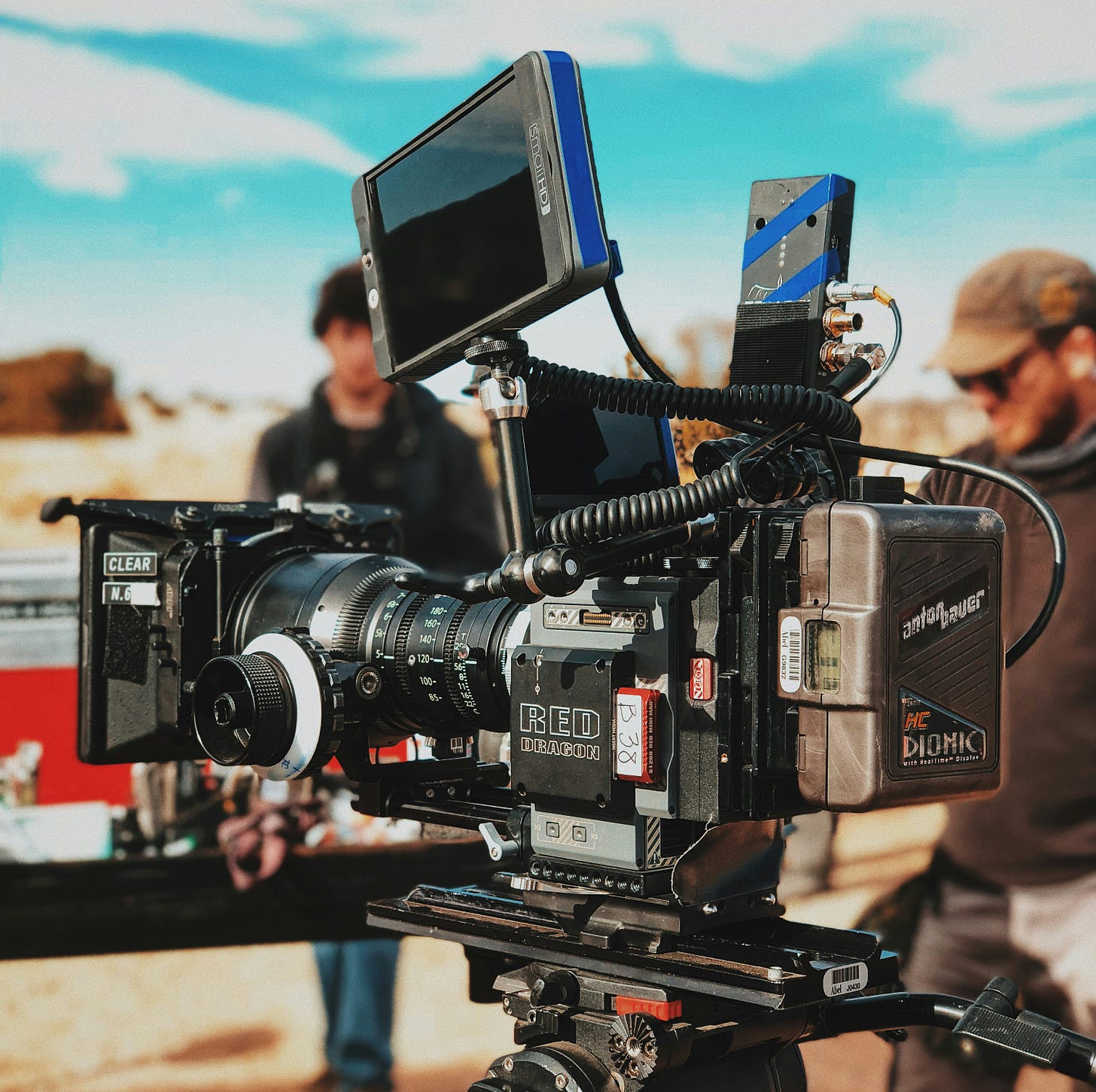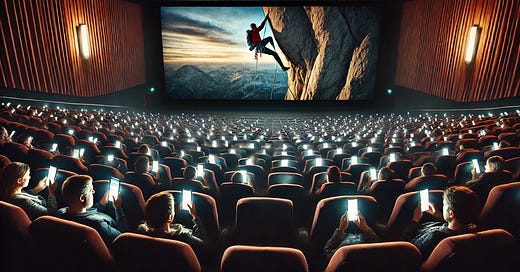Flipping the Script on the Brand Film
Most of the audience will only see the social cutdowns. So why aren’t they the star of the show?
If you work in content production at any level, you’ve had this conversation:
Marketing Leader: “We’re in final editing on our new video project!”
Social Manager: “Cool, I haven’t heard about this project. What is it?”
ML: “It’s a 15-minute documentary about [insert any topic]. It’s amazing, we’re going to put it on YouTube and try to get it into the film festival circuit.”
SM: “Sounds great. What resources do we have for social?”
Marketer furiously types for 5 minutes looking for the contract. Finally, “We have two 60-second cut-downs and some shorter ones. Those might be 16x9. I wonder if they should be vertical?”
SM: “Ugh. What about the people in the film? Do they have any obligations to post?”
ML: “Not sure. We’ll circle back on that. Can you build a promotional plan, we gotta drive a ton of views. Bye.”
This is basically the archetypal conversation of the last 10 years of outdoor industry content marketing, and it would be easy to write a whole post complaining about it. But that’s not where I want to go. (However, I will say that if you’re contracting a brand film, triple or quadruple whatever number of social cutdowns you have in mind.)
My question here is actually more fundamental, and to be honest, I’m still ambivalent about the answer.
I’m increasingly wondering why the brand film is always the main product in the first place. Why aren’t we thinking of the episodic, short- to medium-form storytelling as the actual product, with a 15-minute film at the end, made essentially as a sizzle reel?

The Brand Film Dilemma
The common thread in almost every big content project I’ve worked on in the last 20+ years is that a filmmaker and marketing director first create a big idea – a documentary about unique athletes doing something awesome – and sometime after it’s mostly finished, they remember that they need a promotional strategy.
“Promotional” is the operative term, because the central output is clearly the film. The social cutdowns, email marketing, athlete posting and the all rest are the support structure for the film, not products themselves.
But that framing is the opposite of how the content is actually consumed. Most of the audience will only ever see the “promotional” content, and only a fraction of viewers will remember to watch the 15-minute documentary. So why aren’t we more often building of our content strategy with that in mind?
Quality is Whatever the Audience Says
I would guess that one reason is our general perception of what makes a “quality” story. At the Mediator, Doug Shapiro points out that in media, quality is essentially what the public chooses to spend its time engaging with, and it’s very hard for established producers to adapt. Whole company cultures are built around definitions of quality, and the incumbent leaders benefit from the barriers to entry that a fixed view of “quality” implies.
In essence, this is what I’ve been thinking about for a while here. Athletes and filmmakers have built their business around a specific definition of quality. For a long time that could have been an annual film, which had obvious quality markers — production value, remote destinations, epic action — that were nearly impossible for new entrants to replicate. Similarly, a print magazine required an editorial team, a significant budget and a month of work to make a single “quality” product, not counting all the time photographers and writers spent in the field gathering content.
In skiing, where I was closest to the action, it was the emergence of freeskiing that cracked on the floodgates. Once Level 1 or Poor Boyz could make a quality film from park skiing and urban segments, the incumbent advantage in heli-time and travel budget was significantly eroded.
Eventually those filmmakers moved up the production-level scale, because at least in action sports, I think the public perception of quality is expanding more than it’s changing. It’s not a one-way street. An incredible Alaska segment remains jaw-dropping, but eventually urban segments and new social distribution methods opened the door for individual athlete season edits, which were shorter than a film, but typically still built around amazing cinematography and action.
Then “quality” expanded again, to include 30-second single lines posted on social or TikToky humor videos. Now we’re stoked on one epic wave, one big line or a really funny video shot in the parking lot.
The previous iteration of quality didn’t go away, but we clearly expanded what we’re interested in watching. The public is voting with its attention, and it is telling us that quality storytelling can be a 30-second Reel just as much as a 90-minute film.
The Case for Inverting the Model
So back to the original question, could the contract be inverted to say: Produce a 25-part short-form vertical video and email newsletter series about an athlete expedition, and at the end, if there’s budget left, we’ll pull it together into a longer-form wrap-up video?
This is deeper than the social-first campaigns we typically see, which tend to be either everyone shares the same video simultaneously, or everyone posts their own take on a theme and uses a hashtag and some messaging element to hold it together.
I’m interested in what it looks like to build the whole story around a combination of newsletters, athlete-driven social posting and short-form video. I’m interested in how we effectively tell that adventure story, communicate brand value, and somehow retain a coherent narrative. And I’m really interested in what happens creatively if we truly emphasize short-form storytelling first.
On The Other Hand…
Like I said, I’m also ambivalent about this theory. It’s easy to see where it falls apart.
Sequential storytelling on social media is nearly impossible. If someone finds an episode in the middle of your project, it’s extremely hard to discover the previous or next episodes. And if even if they find episode 1, will they ever see episode 2?
Netflix’s binge watching strategy is even more relevant on social than on streaming. If you somehow manage to catch a person’s attention, you have to keep them engaged as long as possible, because you’re unlikely to get them to return next week to watch more.
One downside of the interest-driven For-You algorithm is that as content tends to just wash over the audience. They have less of a relationship with creators in their feeds, and they may never see anything from them again. In emphasizing short-form first, the brand may lose creator recognition and relationship, making brand value is trickier to assess.
And finally, the documentary film can be an emotional work of art in a way that we rarely see in social video.
But this is a concession to how content is actually consumed. If we’re going to get 100 short form views for every long-form view, why are we building strategy and budgets around the long-form project?
Because it might win an award at a film festival that really, truly almost no one attends? Because it’s easy to send to your boss to rationalize your budget? Because Yeti had a brand-film moment in 2017 that we’re all still trying to re-create?
The positive take is that a 15-minute documentary is an incredibly powerful storytelling vehicle that can communicate more than any social post. And because YouTube drives so much attention, those films may have more legs than ever in the future. And it’s because anything you can do to own your audience instead of renting them on TikTok is a net win.
In fact, there are a hundred reasons why this is a bad idea, except for this one complication – it reflects where people actually spend their attention.
Around the Interwebs
Content as a Commodity
Taylor Lorenz and Patreon CEO Jack Conte had an interesting conversation on YouTube last week in which Conte argued that the interest-driven social graph commoditizes creator content because it abstracts the relationship between creator and follower.
Conte: “What that has essentially done is that it's commoditized creators. It doesn't matter if I get that content from this creator or that creator. It's just corn, it's steel, it's rice, it's literally a commodity. With the follow, the unit of value is the relationship, it's getting to know a person over time, which is very different from the unit of value being the piece of content and then never seeing work from that Creator again.” (Italics mine there.)
Now that same thing is coming for brands and creators near you. You can spend an hour scrolling and never really build a relationship with anyone posting. Some people are better at the game and appear a lot, but don’t underestimate the significance of changing from social graph.






I love this way of thinking: "Produce a 25-part short-form vertical video and email newsletter series about an athlete expedition, and at the end, if there’s budget left, we’ll pull it together into a longer-form wrap-up video?" And if you add AI workflows to this approach, you add another dimension of output and efficiency. I actually have a story pitch out right now that mimics this concept. The media outlet seemed bewildered at first LOL.